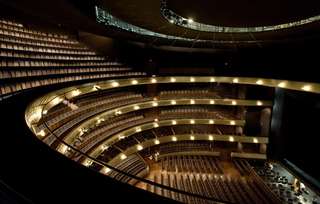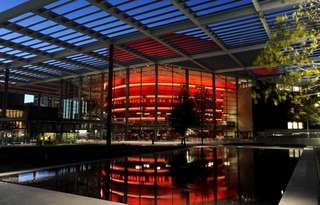|
Back
Otello opens Winspear era in Dallas Dallas
Winspear Opera House
10/23/2009 - & October 25, 28, 31, November 5, 8
Giuseppe Verdi: Otello
Clifton Forbis*/Allan Glassman (Otello), Alexandra Deshorties (Desdemona), Lado Ataneli (Iago), Sean Panikkar (Cassio), Raymond Aceto (Lodovico), Elizabeth Turnbull (Emilia), Scott Quinn (Roderigo), Mark McCrory (Montano)
The Dallas Opera Orchestra and Chorus, Alexander Rom (chorus master), Graeme Jenkins (conductor)
Tim Albery (director), Anthony Baker (sets/costume designer), Thomas C. Hase (lighting designer)

E. Turnbull, A. Deshorties, C. Forbis, L. Ataneli
(© Karen Almond)
After a long journey lasting several decades, the people of Dallas now have a dedicated home for opera. On October 23rd, the Winspear Opera House, part of the city's new AT&T Center for the Performing Arts, opened its doors with a new production of Verdi's Otello, ushering in a new beginning for the city and its opera lovers.
Inside and out, the Winspear is a marvel. The UK based firm Foster and Partners led the design team, creating among other features a modified canopy-sunscreen to protect from the Texas heat; a transparent exterior illuminating the house's red glass interior; a horseshoe style auditorium seating 2,200. The acoustics inside the house are, simply put, the best I've ever witnessed: the softest pianissimo could be heard from all seating levels, and the squillo of the singers on opening night was piercing - voices of all sizes will be pleased with the house's acoustics. The orchestra filled the house with ease and sounded full and rich even on the main level. Two peculiarities: the stage has no prompter's box, and unfortunately the company chose not to install seatback titles, a disappointment for such a modern house and forward looking company.
In Otello, the company's first Winspear production, American Heldentenor Clifton Forbis took the title role and gave a solid assumption of the Moor. Forbis, well known for his prowess in German repertoire, struggled with a throaty lower range throughout the performance but made up for it with a ringing top that pierced through all of the ensembles with remarkable ease. He seemed a bit cautious during the Act I love duet, but warmed up after intermission to deliver a rousing "Ora e per sempre" and a chilling "Si, pel ciel!". His best dramatic moment came during the Act III duet with Desdemona (which for some reason incited the Dallas audience to laughter) as he vacillated between restrained anger, sharp cynicism, and unleashed rage.

Winspear Opera House interior (© Karen Almond)
Baritone Lado Ataneli as Iago showed the most charisma throughout the night. Of the (few) legitimate Verdi baritones in the world today, Ataneli belongs near the top. The Georgian moved about the new stage with purpose and intent, never becoming a caricature of the Shakespearean villain. His "Credo" burst throughout the house with ease and poignancy, and he sang with power but no bluster during "Si, pel ciel!". Of the principals, Ataneli was in a class above the others, both vocally and dramatically.
Canadian soprano Alexandra Deshorties played the heroine when only a few weeks before opening night she overtook the role of Desdemona from German soprano Annette Dasch. Making her company and role debut, Deshorties performed admirably if not perfectly. Her wide vibrato isn't for everyone, and she seems to have only two volumes in her upper register (loud and louder), but on opening night she executed some exquisite pianissimi and showed off fine legato during both of her Act IV arias. Deshorties had a tendency to exaggerate both her acting and pronunciation, but the role should come more naturally to her as she has more time to develop Desdemona.
Tenor Sean Panikkar brought a light, clear voice to the role of Cassio. The American acted well and showed an unusual amount of bravado; he has a bright future. Raymond Aceto showed why he is one of America's foremost basses, booming effortlessly in his brief but powerful appearance as Lodovico.

Winspear Opera House exterior (© Karen Almond)
Unfortunately, Dallas music director Graeme Jenkins had some issues with the score. The conductor couldn't keep orchestra and cast together at several key points during the opera, notably during the choral ensembles and also during Iago's brindisi where Ataneli was at various points ahead of and behind the conductor's pace. The brass section seemed a bit lackluster during the first two acts. Conductor and orchestra improved as the night went on, finishing with a splendid Act IV.
Anthony Baker's updated (but not modern) production was serviceable with occasional moments of creativity. Baker's concrete sets evoked the inside of a battleship or even a prison, with levels separated by flights of stairs. This allowed for more credible character separation during the interwoven but independently sung ensembles, and worked well during the Act III trio, giving Otello several clever hiding places. Lighting designer Thomas C. Hase deserves credit for his schemes, as his shades incorporated the red hues of the Winspear into the bloody tale of the opera itself. He made a wise choice in letting characters step into light instead of having it find them, making the stage direction more natural and organic. In the end the safe production kept it simple, letting the cast and the new house take center stage.
With a successful new Otello, a new house, and a new fervor from the city's residents, Dallas Opera has without question joined the ranks of the elite houses in the country.
The Dallas Opera
Paul Wooley
|